Google Nexus 5 Review
by Brian Klug on December 5, 2013 8:00 AM EST- Posted in
- Smartphones
- LG
- Android
- Mobile
- Snapdragon 800
- Android 4.4
- Nexus 5
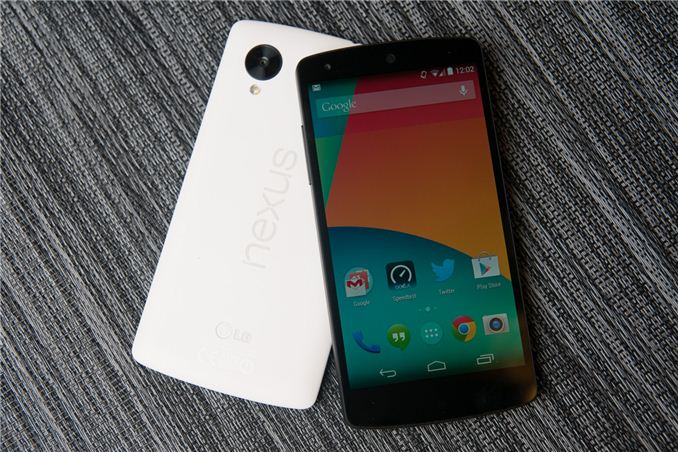
Each year, Google picks a silicon vendor, a hardware partner, and releases a new version of Android running on top of them. The result is a Nexus phone, and for five iterations now that process has repeated, resulting in a smartphone that’s the purest expression of Google’s vision for its mobile platform. Today we’re looking at the Nexus 5.
Nexus 5, as its name makes obvious, is the latest generation of Google’s line of Nexus smartphones, and also is topped by a 5-inch display. While the Nexus program originally started only for smartphones, we’ve seen Google since extend the program to include a 7-inch and 10-inch tablet form factor, as well as a line of accessories. In recent years, we’ve seen Nexus go from being part enthusiast curiosity and development device, to a brand tailored for consumers looking for the latest and greatest the Android platform has to offer at a killer price.
Last generation we saw the Nexus 4, a device that was essentially an LG Optimus G for T-Mobile in different clothing and priced at a competitive price, yet still included the latest and greatest silicon from Qualcomm with APQ8064 (S4 Pro). For Nexus 5, Google has once again gone with hardware partner LG and silicon vendor Qualcomm, this time with a phone that’s somewhat analogous to the LG G2 (but not exactly the same platform) and using the latest and greatest MSM8974 (Snapdragon 800) silicon.
Let’s start with the hardware, since that’s the normal flow for a review. The Nexus 4 bore a lot of superficial similarities to the Optimus G, including a glass back with laser etched design below its surface, the same display, banding, and materials. The Nexus 5 on the other hand doesn’t bear any similarities to the G2, with its buttons on the back, narrow bezel, rounded backside, and glossy plastic. Instead, the Nexus 5’s design borrows much of its industrial design language from the Nexus 7 (2013), with the slightly rounded top and bottom, landscape “nexus” logo on the rear, and large radius curves all around the side. The Nexus 5 and 7 share almost the same shape and profile, and in the case of the black Nexus 5, same rubberized soft touch material on the back and sides. If you scaled down the Nexus 7 design you’d get something which is awfully close to the Nexus 5.
The result is a two-device family that feels like it was made by the same company, and it’s really the first time Google has aligned its industrial design in such a sweeping fashion, in this case even across two different hardware partners. I guess you could make the argument that with the exception of the Nexus 10, Google has eliminated any industrial design fragmentation and finally crafted some hardware design language that it owns for itself.
Google sampled us first a black Nexus 5, and later a white Nexus 5 at my request so I could check out the material differences I saw some discussion about. It’s true that there are some differences between the two devices. For starters, the white device has a backside which eschews the soft touch material, instead giving the polymer-backed device a rougher, textured feeling. The absence of soft touch continues to the edge, which is glossy black plastic instead of the rubberized material, and comes with protective plastic installed over it by default. On the front the only visible difference between white and black is a white colored earpiece, the rest of the bezel around the display is still black.
I’m reminded of the split between the white and black Note 3 with the Nexus 5, which also only includes rubberized material on the black model. I find myself preferring the feeling of the white model instead, but it’s really just a story of personal taste. No doubt the absence of soft touch on the white material is to prevent staining from hand oils or other dyes as the device ages. I don’t find that the absence of soft touch on the white model makes it any more difficult to hold or grip onto, the negative-angled bezel really does help the Nexus 5 fit into the hand securely.
Although the Nexus 5 is a close cousin, it doesn’t adopt the button arrangement from the G2, instead locating the volume and standby buttons in a normal place. Volume rocker ends up on the left, power on the right side.
Likewise earpiece is on top and microUSB is at the bottom of the device. What’s unique about the Nexus 5 buttons is the material of those buttons – they’re ceramic, not polycarbonate. The result is that they’re sharp and instantly locatable with the brush of a finger, it’s a subtle thing that does feel different. The only complaint I have is that they do seem to rattle slightly inside their cutouts. I can affirm that the white model seems to have less rattle, but I’m not entirely sure how much of that is intrinsic to the color difference and absence of soft touch.
Also on the back is the Nexus 5’s oversized camera cutout, which is slightly raised from the surface around it. It’s fair to say that the Nexus 5 does have a camera bump, something that’s not going away soon in all but the most iconic devices. When I first saw the oversized ring, I assumed it was just a design motif, and others later speculated it was for a line of magnetically-attachable add on lenses. To date none of those have materialized, and upon further consideration having magnets next to the VCM (voice coil motor) electromagnetic focus and OIS mechanism could complicate things. In any case, at present the oversized ring around the camera aperture is a unique design point rather than something which serves a function.
The only real negative about the camera cutout is that dust seems to be able to get into the crack surrounding it and the cover glass. It’s something unfortunate about the Nexus 5’s design in general – there are cracks that show dirt quickly, for example the backside has a seam around the edge where dust seems to intrude. It obviously doesn’t change the Nexus 5’s function, but immediately starts looking dirty on the black model, and part of why given both side by side I prefer the white one.
I think pragmatic describes the Nexus 5 design quite well, since honestly the design doesn’t try to be flashy just for the sake of differentiation or make any crazy materials choices on the outside. There are subtle design features which definitely are appreciated, however, like the negative angle to the edge which makes the device easy to grip, those ceramic buttons, and the continuity of design language from the Nexus 7 of course. Materials are a big differentiator between devices right now, and again the Nexus 5 is relatively pragmatic with its choice of polymer, but does deserve kudos for not going with the slick, glossy-surfaced material still preferred by Korean handset makers.
The Nexus 5 feels well made and precision crafted, but I can’t shake the feeling that Nexus 4 felt more like a standout design of its own. The Nexus 5 seems a lot more, well, traditional, without the rounded-glass edges, chrome ring, or pattern below the glass on the back (which I still maintain contained some kind of encoded message). The reality is that Google made a lot of decisions with Nexus to optimize for cost, and that the Nexus 5’s design is actually quite differentiated given the price.
The Nexus 5 adds a lot over its predecessor – larger 1080p display, newer silicon, 802.11ac, better camera with OIS, and of course LTE connectivity, all while getting minimally more expensive than its predecessor. It’s almost unnecessary to say that the Nexus 5 is obviously the best Nexus phone yet.
| Physical Comparison | ||||
| LG G2 | Samsung Galaxy Nexus (GSM/UMTS) | LG Nexus 4 | LG Nexus 5 | |
| Height | 138.5 mm | 135.5 mm | 133.9 mm | 137.84 mm |
| Width | 70.9 mm | 67.94 mm | 68.7 mm | 69.17 mm |
| Depth | 9.14 mm | 8.94 mm | 9.1 mm | 8.59 mm |
| Weight | 143 g | 135 g | 139 g | 130 g |
| CPU |
2.26 GHz MSM8974 (Quad Core Krait 400) |
1.2 GHz OMAP 4460 (Dual Core Cortex A9) | 1.5 GHz APQ8064 (Quad Core Krait) |
2.26 GHz MSM8974 (Quad Core Krait 400) |
| GPU | Adreno 330 | PowerVR SGX 540 @ 304 MHz | Adreno 320 | Adreno 330 |
| RAM | 2 GB LPDDR3 | 1 GB LPDDR2 | 2 GB LPDDR2 | 2 GB LPDDR3 |
| NAND | 16/32 GB NAND | 16/32 GB NAND | 8/16 GB NAND | 16/32 GB NAND |
| Camera | 13 MP with OIS and Flash (Rear Facing) 2.1 MP Full HD (Front Facing) | 5 MP with AF/LED Flash, 1080p30 video recording, 1.3 MP front facing | 8 MP with AF/LED Flash, 1.3 MP front facing | 8 MP with OIS, AF, LED flash, 1.3 MP front facing |
| Screen | 5.2-inch 1920x1080 Full HD IPS LCD | 4.65" 1280x720 SAMOLED HD | 4.7" 1280x768 HD IPS+ LCD | 4.95" 1920x1080 HD IPS LCD |
| Battery | Internal 11.4 Whr | Removable 6.48 Whr | Internal 8.0 Whr | Internal 8.74 Whr |
Google also sent over one of the Nexus 5 bumper cases, which really isn’t so much bumper as it is, well, all around case. The Nexus 4 had bumpers that wrapped around the edge, but left the glass back exposed, much like the iPhone 4/4S era bumpers.
Nexus 5’s bumper case covers up everything but the oversized camera aperture on the back. The red one I got doesn’t seem to be silicone but some other thermoplastic.
At $35 it’s a bit on the pricey side, but it does fit the device nicely and get the job done with some cool neon colors that spice up the Nexus 5.


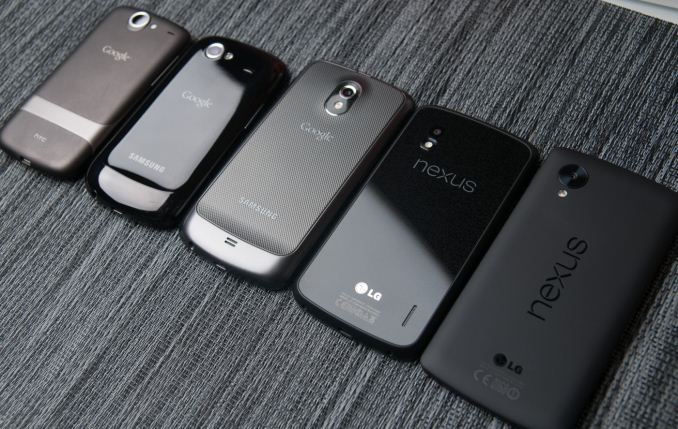
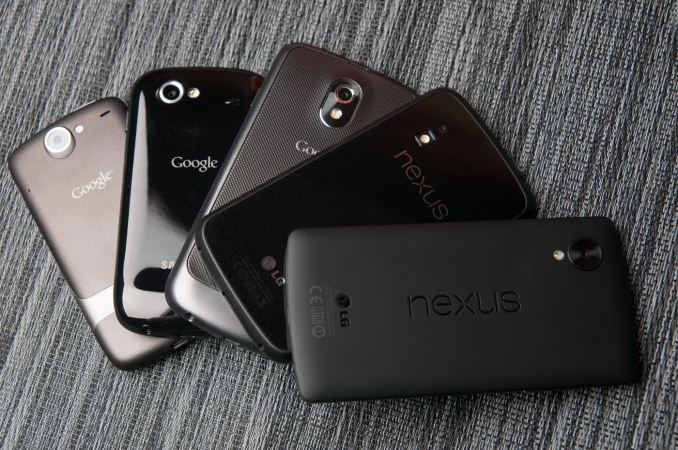
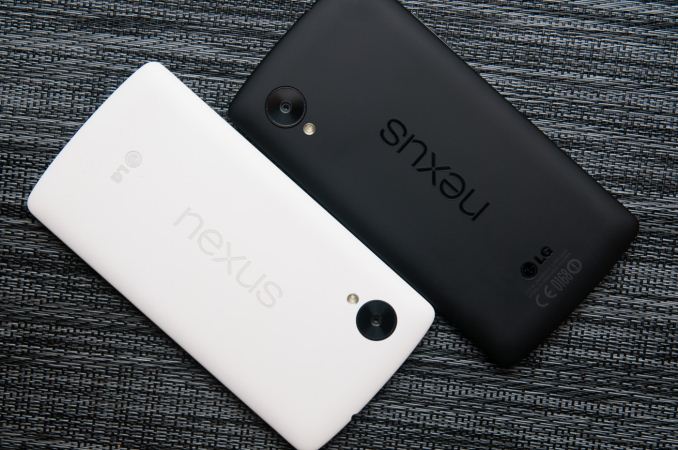
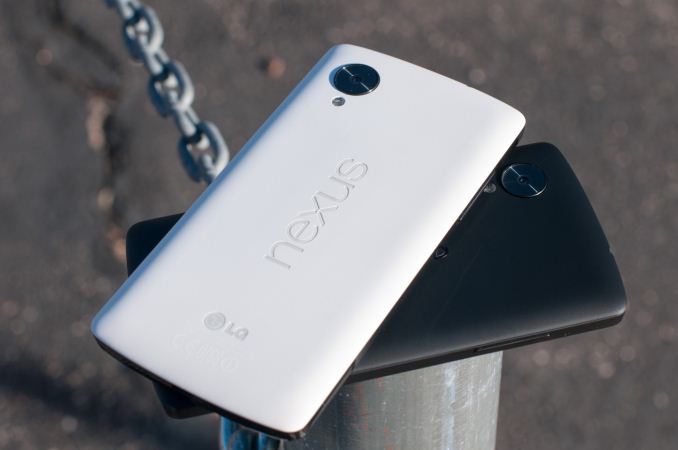
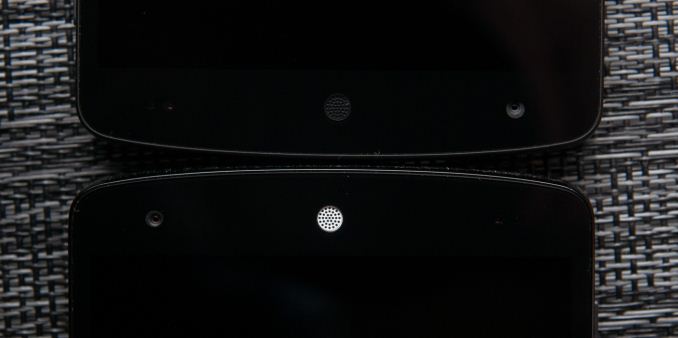
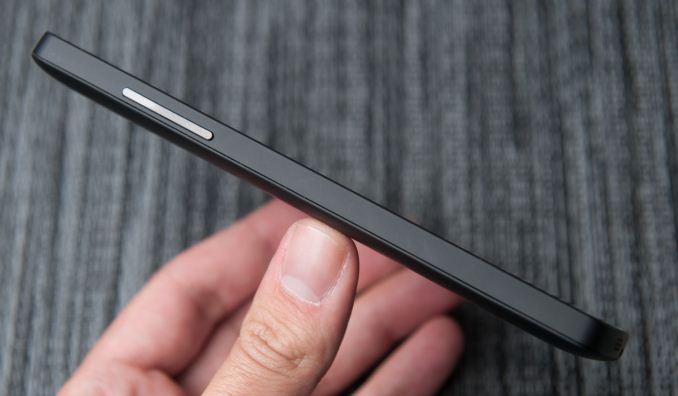
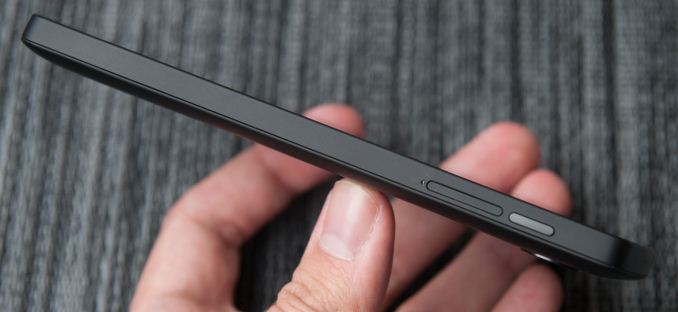








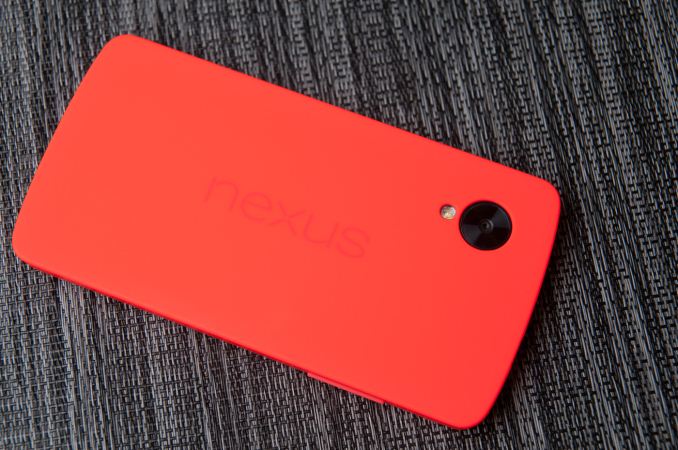
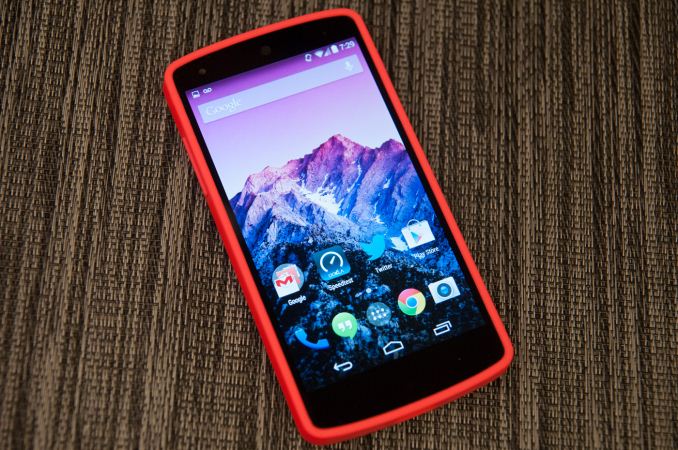








231 Comments
View All Comments
A5 - Thursday, December 5, 2013 - link
You can't just ignore the app count when talking about these devices. No way the 2520 is the best tablet.thunderbird32 - Thursday, December 5, 2013 - link
Even as far as non-Android/iOS tablets go the 2520 isn't the best. I'd much prefer Dell's Venue tablets. Full version of Windows on a Bay Trail SoC is so much more useful than RT on ARM.zoetrope - Thursday, December 5, 2013 - link
Why don't you WinTards troll elsewhere? Enough of the whining and "poor me" attitude. The intertubes is big enough for your ilk, go visit a WP echo chamber like wpcentral.com and keep out of comment sections if you can't stay on topic.Wade_Jensen - Thursday, December 5, 2013 - link
I am thoroughly against insulting people in such a manner, but WinTard is possibly the most hilarious thing since S-gimmick and S-fail.hrrmph - Thursday, December 5, 2013 - link
The greatest tablet? The 2520?Well maybe almost. Nokia specs show the Micro-SD slot to be a crippled version with a 32GB max capacity.
For many people, the low storage capacity makes it DOA, falling down straight out of the gate. There are just too many competing devices that have 64GB capable Micro-SDXC slots.
Of the course, the Nexus 5 is a zero in this category, since it has no slot for Micro-SD of any type.
jimbo2779 - Friday, December 6, 2013 - link
I'm going to ignore the childish name calling for a moment and just say that while I am a big fan of WP and windows tabs I seriously doubt the 2520 is going to be the best tablet going, on paper it has decent hardware and Nokia build quality if great it is still going to be running RT.RT has/had a huge amount of potential but without more app support it will never draw in the crowds and that will in turn not lead to more apps so it is a vicious cycle that I doubt will be changing any time soon. As an OS it is pretty great and you only need to look at some of the fan vids of it online where people are gaming on the tab while watching a video on a TV or vice versa, there is some serious potential to it but without the app support it is likely to stay at potential.
As for WP reviews I do agree that it is very disheartening to not even have some cursory reviews/overviews of them. It really wouldn't be that hard to get a few of the key devices and at least battery test them. At this point a few days of testing would really go a long way to showing how they stack up in terms of battery life.
It is disappointing to not have any real consideration for what is a good phone OS and its devices. Market share is increasing and as it does so will app support and if AT is not careful they could be in a position where WP is more of a serious player (it already is in some parts of the world) and none of the writing staff will have much of an idea about what it is all about.
BoneAT - Thursday, December 5, 2013 - link
Having a whole year to work on the device an two to work on Key Lime Pie, I'm surprised how rushed the Nexus 5 feels. The camera thing is a mess as if there were very, VERY late decisions to include OIS and exclude the new API, and ppl. are reporting wakelocks all over the place.Build quality is extremely worrysome based on drops tests, each ending brutally plus the speaker placement blocks clear sound coming through, boyz @XDA improved it significantly drilling small holes into the plastic underneath.
And then there's the battery - it seems Google understands the flagship concept as far as specs and SW goes, but 4hr SoT on normal use of Google services is NOT flagship level. With a price bump I wonder how they failed to address the Nex4's biggest issue (not much real world improvement based on dozens of N5 XDA users).
Now when you have the camera focus right, when you manually improve the speaker, when you protect it from the smallest drops and when you use all around (excluding all non-KitKat compatible apps), the Nexus 5 is the most successful realization of the Google Phone. These annoyances however makes it a questionable buy, never mind the price tag. The Moto X might just be a better buy considering you get two for one Nexus 5.
THX - Thursday, December 5, 2013 - link
I'm guessing you went with a different phone and are trying to justify your purchase by trashing the shinier, newer, more performant option. :)Maybe I'm missing something but how is the Moto X half the cost of the $350 Nexus 5?
BoneAT - Thursday, December 5, 2013 - link
No criticism, no improvement, buddy. I'm a Nexus user so hit any miss on your cyber bullying attempt, but thx for spotting out my Moto X - Moto G mix-up.THX - Thursday, December 5, 2013 - link
Nexus 4 user? Just sell your phone and get the 5.And I think anyone here would rather have a single fast phone than 2 slow ones, or was there a specific use-case you had in mind?